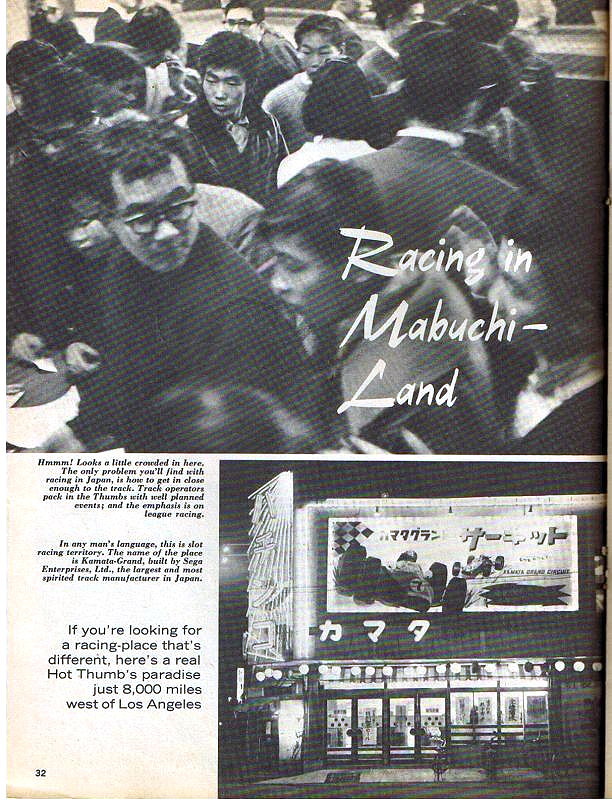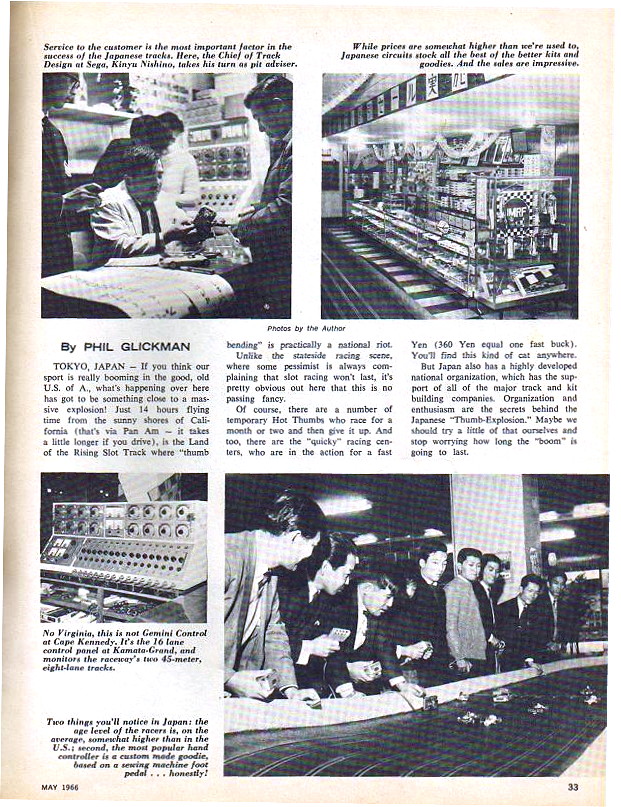So what happened? Any Japanese members here who can fill us in?
Don



Posted 31 May 2014 - 07:30 AM
Posted 31 May 2014 - 08:56 AM
Posted 31 May 2014 - 09:16 AM
But Japan also has a highly developed national organization, which has the support of all the major track and kit building companies. Organization and enthusiasm are the secrets behind the Japanese "Thumb-Explosion." Maybe we should try a little of that ourselves and stop worrying how long the "boom" is gonna last.
Gregory Wells
Never forget that first place goes to the racer with the MOST laps, not the racer with the FASTEST lap
Posted 31 May 2014 - 09:51 AM
That question should be directed to Haruki when he gets home and relaxes.
John Andersen
DR Racing Products
Posted 01 June 2014 - 05:41 PM
Anthony 'Tonyp' Przybylowicz
5/28/50-12/20/21
Requiescat in Pace
Posted 29 August 2014 - 08:09 PM
There was a huge boom of slot car racing in Japan, starting in 1964 & coming to an abrupt end in 1966.
After 1966, fewer & fewer commercial raceways survived but around 1970 it was very difficult to find raceways in active business.
At that time slot cars were luxury to most Japanese people, especially imported American kits such as Revell, Monogram & Cox were prohibitively expensive because Japanese currency, Yen, & Japanese economy was so weak: 360 yen equaled to $1 at that time, while it is 103 yen equals $1.
At the beginning of the hobby's boom there was a national organization controlling the hobby: Japan Model Car Racing Association.
They had a very extensive set of regulations, supported by raceway, manufactures & distributors.
This boom died very suddenly like in the States, mostly because similar reasons in the States, but the hardest blow here in Japan was many schools prohibited their students from racing slot cars at commercial raceways because the hobby was so expensive that young stars would commit a crime to make money for the hobby.
This magazine article posted by Don is dated May 1966, so the pictures are those of a booming raceway in Tokyo.
I raced at that raceway, Kamata Grand Circuit, located at upstairs of Kamata Grand pachinko(Japanese pinball) parlor.
Such pinball places are legal game place but players can change balls for some candies & goods, which can be changed for money at special shops(in this sense it is semi-illegal): http://en.wikipedia.org/wiki/Pachinko
Sega, who ran a lots of raceways then was famous for their pin ball/smart ball operation & now computer games.
There was a big race at Kamata Grand in 1967. I raced their as a member of another active raceway but we were defeated very badly.
In 1968, there was the last Nat's in Akasaka, Tokyo.
Our raceway factory teams won the perfect win finishing 1st to 3rd, while my team, a junior team, finished 8th.
Our Retro Tokyo chassis kit producer, Nobu Hanada, belonged to one of Kamata Grand teams. racing against our raceway teams at that event. His team finished 7th. This was found out when Nobu & I talked when we raced wing cars almost 25 years ago. Now we are racing retro together. Nobu & I have been hooked on this hobby for 50 years. LOL
Haruki
Posted 29 August 2014 - 08:31 PM
Dennis David
Posted 30 August 2014 - 12:27 AM
Haruki -
I read the story of your experience in Japan's slot car golden age with great interest.
You lived through a brief, unique period and must cherish rare memories. ![]()
Posted 30 August 2014 - 02:31 AM
Hi James,
The booming years of 1964-66 was like dream days to me.
There were 3 to 5 commercial raceways within 10 minutes' bicycle ride from my home.
From around 1967, It was very sad to see many raceways were closing down so rapidly.
I took me 40 to 90 minutes by train to get to survived raceways.
In 1967 I started to race at Raceway Musahino, located in the western suburb of Tokyo.
The raceway was so far away to a second-year student of junior-high but I go to race there every Sunday.
The raceway owner loved the hobby so much that there were many jet racers & super builders.
I quit racing in 1969 but th2e raceway survived a few more years, hosting Car Model series races of Tokyo with some raceways at US military bases around Tokyo, as shown in the following picture:
After 50 years, I invited 2 Musashino jet racers to my raceway.
2nd from right is "Bat," & super jet Toriguchi "Daichan" on his left as shown below:
Haruki
Posted 30 August 2014 - 02:49 AM
Don. What magazine was that ?
Hi Dennis,
It was in Model Car & Science, May 66. But there was also another article by the same author, Phil Glickman (I think he was one of the publishers) in the May 66 issue of their sister mag, Model Car & Track: Ginza a Go-Go.
Haruki,
Thank you very much for your story and your explanations. The story about high schools banning slot racing because some kids were stealing to support their hobby seems incredible to me: do you think it's really true? That couldn't have involved more than a tiny fraction of kids who were racing.
Also, another question: how did racers see the US versus Japanese products? Did Japanese racers favor the imports, even at much higher prices? Or were they about equivalent in performance (depending on the year I guess)?
I'm also asking because in his autobiography, Mr. Tamiya claims that when he went to the States with his slot cars they were far superior to the equivalent US models, and distributors refused to handle them to avoid competition with domestic products...
Was it the same evolution in Japan, with racers quickly moving from kits to RTR, to semi-scratch (Dynamic...) and then full scratchbuilt cars, with rewound motors, etc.?
Thanks again for your contribution!
Don
Posted 30 August 2014 - 03:22 AM
Don,
I don't think many youngsters stole money because of slot car racing, but its boom was so big that the hobby became a good target of narrow-minded teachers & journalism.
At the beginning of the boom, 1964-65, American kits such as Revell, Monogram, K&B, Cox were superior to Japanese kits.
Until Tamiya introduced 1/24 McLaren Elva kit with a full rear suspension chassis in 1966, it was difficult to win races with Japanese kits unless you modified well.
Tamiya's first 1/24 kit, Lotus 30, was OK but not as good as its successor, McLaren Elva.
The McLaren chassis was made of brass, so it was easy to modify it by soldering.
For the time being, Tamiya kits & their modified ones as semi-scratch chassis did well at races but jet racers were switching to scratch-built chassis with rewound motors to win races.
I found what we raced at 1968 Japan Nat's:
Haruki
Posted 30 August 2014 - 08:16 PM
I remember I saw an article of Phil Glickman's visit to Japan in a Japanese modelcar magazine.
Around 1967, surviving raceways became more like battle-fields for serious racers from playgrounds for modelcar lovers.
It was very difficult to get hi-end tune-up parts from the States because US dollars were much higher against Japanese Yen.
Most of such parts were produced in Japan but they were not available to Japanese racers.
Japanese clear plastic bodies were mostly repop of Lancer's or other American manufactures & some Japanese original ones but their quality was not so good.
As for rear tire size, Japan Modelcar Racing Federation stuck to bigger size such as 25mm(about 1 inch) for GT-1(Can-Am & Sportscars with biggerl engines) & 23 mm(.090 inch) for GT-2 such as Porshe 906. These big rears were too much for such American bodies as Dynamic's handling bodies. Our team would like to put on smaller tires, so we chose Tamiya's very light-weight plastic bodies of 906 with clear plastic canopies, although its car-width was limited to 75mm(2.95 inch) while GT-1 with bigger rears were allowed up to 80mm(3.15 inch) car-width. I am not quite sure but minimum front tire size was as same as the rears, so we tapered the fronts, setting them with large degree of negative-camber to clear the front fenders.
In 1968, all the racers raced Mabuch 26D endbell-drive, rewound by individual racers. There were no professional motor tuners in Japan.
Those rewound 26D's had no brakes, so we connected 1.5 to 3.0V batteries to the braking switches of controllers.
Haruki
Posted 04 October 2021 - 05:04 PM
Posted 04 October 2021 - 06:37 PM
Haruki, thanks for your memories and report.
Matt Bishop